Dunshaughlin, Co. Meath
Dunshaughlin Poor Law Union was formally declared on the 1st April 1839 and covered an area of 170 square miles. Its operation was overseen by an elected Board of Guardians, 26 in number, representing its 12 electoral divisions as listed below (figures in brackets indicate numbers of Guardians if more than one):
Co. Meath:
Culmullen (2), Donaghmore (2), Dunboyne (3), Dunshaughlin (2), Kilbreu (2), Kilcloone (2), Killeen (2), Kilmessan (2), Rathfeigh (2), Ratoath (2), Skreen (2).
Co. Dublin
Garristown (3).
The Board also included 8 ex-officio Guardians, making a total of 34.
The population falling within the Union at the 1831 census had been 22,240 with Divisions ranging in size from Donaghmore (population 1,250) to Dunshaughlin itself (2,547).
The new Dunshaughlin Union workhouse was erected in 1840-41 on a five-acre site 1.5 miles to the south of Dunshaughlin. Designed by the Poor Law Commissioners' architect George Wilkinson, the building was based on one of his standard plans to accommodate 400 inmates. Its construction cost £4,938 plus £912 for fittings etc. The building was declared fit for the reception of paupers on 12th May, 1841, and received its first admissions on 17th May. The workhouse location and layout are shown on the 1909 map below.
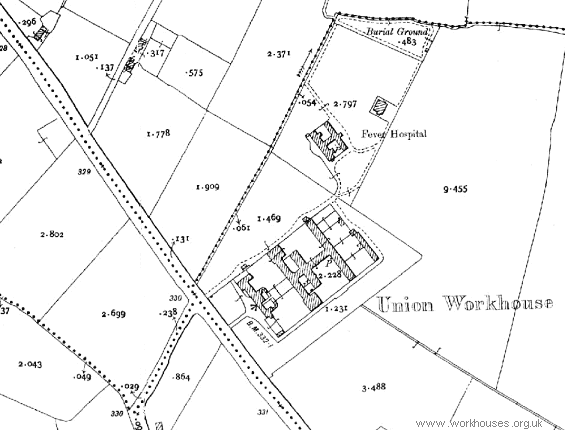
Dunshaughlin workhouse site, 1909
The workhouse had a two-storey entrance and administrative block facing to the road at the west. On the first floor was the board room where the Guardians met on Tuesday each week.
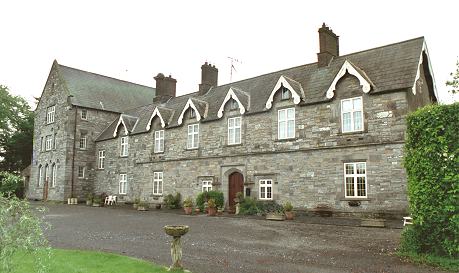
Dunshaughlin entrance and administrative block from the south, 2002
© Peter Higginbotham.
During the famine in the mid-1840s, stables and probationary wards were converted into sleeping apartments to accommodate an additional 71 inmates. Initially, 25 fever patients were treated in a house hired for use as a fever hospital, with the workhouse stables also fitted up for the reception of new patients. A fever hospital was subsequently erected to the north of the workhouse. A burial ground was located to the rear of the workhouse.
In the late 1840s, the block was extended at its northern end with the addition of a three-storey wing containing children's accommodation and schoolrooms.
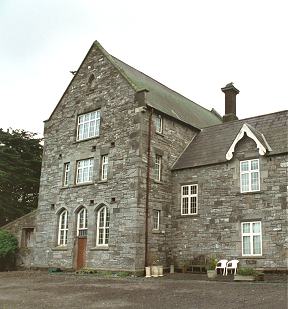
Dunshaughlin children's wing from the south, 2002
© Peter Higginbotham.
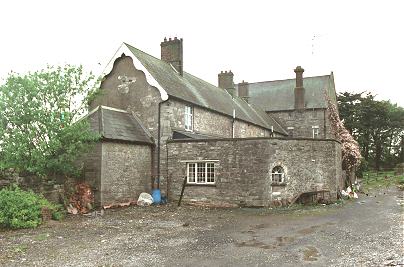
Dunshaughlin entrance and administrative block from the east, 2002
© Peter Higginbotham.
To the rear of the administrative block stood the two-storey main accommodation block.
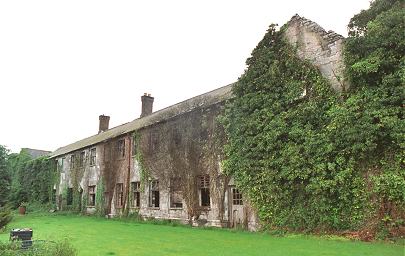
Dunshaughlin accommodation block from the south, 2002
© Peter Higginbotham.
The accommodation block was linked to an infirmary at the rear by a central spine containing the dining-hall and chapel. A small ventilation tower in the centre of the infirmary improved the circulation of air through the building.
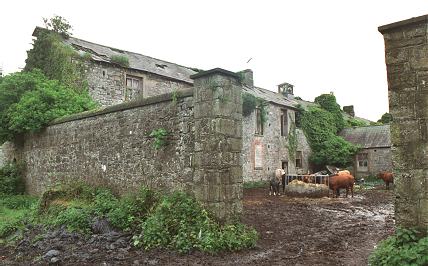
Dunshaughlin infirmary from the west, 2002
© Peter Higginbotham.
A single-storey block at the rear of the site may be the former workhouse stables.
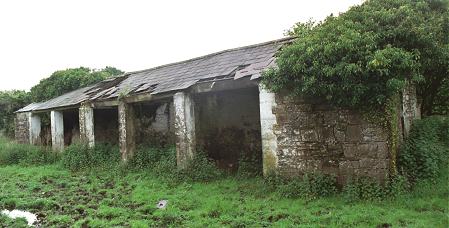
Dunshaughlin stables from the south, 2002
© Peter Higginbotham.
In the post-famine years, the workhouse rarely had more than a few dozen inmates. At the start of the First World War, the site was initially commandeered for military use. After being found unsuitable for accommodating soldiers, it was fitted up to house 125 Belgian refugees and thereafter became as a holding depot for refugees until they could be placed elsewhere. Some refugees died during their residence at the workhouse and were buried in the paupers' graveyard. In 1920-21, the building was taken over as a barracks by the 'Black and Tans' — a British reservist force — during the War of Independence.
Following the creation of the Irish Free State in 1922, the workhouse system was abolished. The workhouse buildings subsequently had a variety of uses including a school, a courthouse and a factory.
The entrance and administration block has now been refurbished for use as a guest-house. In 2002, the remainder of the buildings were derelict. Plans for their redevelopment have been the subject of much local debate.
Records
Note: many repositories impose a closure period of up to 100 years for records identifying individuals. Before travelling a long distance, always check that the records you want to consult will be available.
- Meath County Library, Railway Street, Navan, Co. Meath. Holdings: Guardians' Minute Books (May 1839 - May 1843, Apr 1846 - Jan 1848, Dec 1848 - Feb 1850, Jan 1851 - Dec 1891, Jan 1893 - Nov 1921); Rough Minute Books (Jan 1856 - Dec 1857, Jan 1863 - Dec 1863); Miscellaneous statistics (c.1915-19, including daily return of inmates, Belgian refugees housed in Dunshaughlin workhouse, including arrival and departure dates).
Bibliography
- Crossman, V (2006) Politics, Pauperism and Power in Late Nineteenth-century Ireland
- Gray, P (2009) The Making of the Irish Poor Law, 1815-43
- O'Connor, J (1995) The Workhouses of Ireland
Links
- None.
Unless otherwise indicated, this page () is copyright Peter Higginbotham. Contents may not be reproduced without permission.


